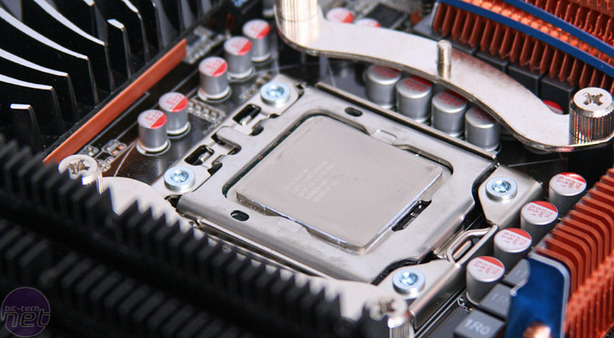Going for glory... how far can we push the i7 920?
Pushing the Core i7 920 up to 4GHz was fantastically easy to get stable. However, when we tried to take things beyond 4GHz, it was like we had hit a stability brick wall.One thing is certain then - getting over 4GHz out of these CPUs will separate the men from the boys in overclocking or at least those with time to commit to it because it demands time playing with the finer settings like clock skews.
We got it to boot at 4.3GHz just fine, but the increments in Core voltages were sizeable and our temperatures were rapidly hitting 50˚C idle, even with an extra fan fitted to the Ultra eXtreme - we tried the Noctua heatsink as well without luck.
We could get 4.3GHz to boot into Windows, but any attempt at loading the CPU for a length of time caused continual blue-screens. Over 4.3GHz and there was no POST at all, regardless of voltages and memory frequency.
 We've heard from multiple industry sources that over 4GHz, things get a lot tougher and while our friends at Custom PC have had a Core i7 at an impressive 4.27GHz stable.
We've heard from multiple industry sources that over 4GHz, things get a lot tougher and while our friends at Custom PC have had a Core i7 at an impressive 4.27GHz stable.However, it was with a more expensive 965 at a whopping 1.575V vCore and with only 177MHz on the QPI bus. In comparison, 4.3GHz on a Core i7 920 runs a faster QPI base clock of 215MHz because it can't use the additional CPU multipliers.
Should I get one then?
Clearly the performance gains for the overclocking are there for all to see - 4GHz seems like a huge number but it took no time at all to reach, given the appropriate hardware to complement it and we could run it all day at this speed. In particular, the performance increments in multi-threaded applications that further benefit from the increase in clock speeds are potentially HUGE. With a 50 percent performance improvement from a 50 percent overclock in Paint.NET, Cinebench and 7-Zip, then 25 to 41 percent improvement in video encoding will have a few people getting rather aroused as they reach for their credit cards.If you're a hardcore gamer though, we have to say that we're with Nvidia on its "optimise your PC" stance - the oodles of GHz that we thought would make a difference actually don't to a large extent and you're better off buying into more graphics which is the limiting factor at high resolutions.
The Core i7 920 itself provides some fantastic value from a CPU - we'd be inclined to suggest more than the Q6600 considering the greater breadth and higher clocks it can achieve, however that's before taking into account the board and memory costs. Most people that bought a Q6600 spent about £80-130 on a motherboard, while some spent about ~£150-£180 if they really wanted some super features or the best chipsets. Very few bought the £250 Rampage Extreme.

Now we're faced with the average board cost hitting £280 (although the Intel Smackover is £240), and that scales upwards to ~£335 (or more as we haven't seen every X58 board yet). This is mostly due to the complex eight-layer PCBs adding an extra 33 percent to the production costs. It's true that graphics cards use even thicker ten or even 12 layers, but their size is a lot smaller at under half that of ATX. Couple that with costly £200 triple-channel DDR3 kits and we're looking at a total platform cost of nearly £700 before graphics. That's twice as much compared to a Q6600 with a feature rich P45 motherboard and 4GB of 1,066MHz DDR2, or 8GB of 800MHz DDR2.
Do you get twice as much performance for twice the price? No. 50 percent more? Hmm maybe, but it depends what you do. 50 percent is still a fantastic improvement, but I don't spend my entire day encoding video, batch converting pictures or compressing files. The problem Intel has now in appealing to enthusiasts is twofold: the CPU pricing is not the problem considering the evolutionary performance potential, but since we've been enjoying extremely low DDR2 prices for a long time now, this has spoiled our sense of value.
Most of all, motherboard prices will have to come down dramatically to entice people - this means Taiwan has to develop a six-layer PCB and we'll likely end up with just three memory slots instead of six (should you care). Alternatively, we just have to wait for eight-layer PCBs to become economical - it took a while for initial six-layer motherboards to become affordable, for example, and now they're used almost everywhere.
In a nutshell, the Core i7 920 is an overclocking monster and it delivers industry leading video encoding, image compressing, thread munching behemoth and a great value CPU. However, it sits in an expensive new platform that sniffles at games, still. Most of us will want to wait this launch out and see what happens as DDR3 kits drop in price and new X58 boards are launched.
What we're missing is a wide selection of Core i7 920 overclocking experiences, so we're keen to hear how our readers are getting on with overclocking their Core i7 920s. If you've had a good (or bad) experience overclocking your CPU, share it with your fellow readers in the forums!

MSI MPG Velox 100R Chassis Review
October 14 2021 | 15:04









Want to comment? Please log in.